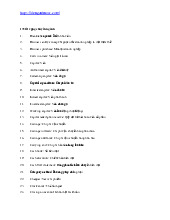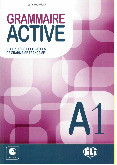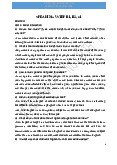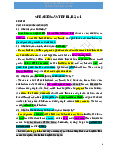

















Preview text:
IELTS Sample Diagram/Process (IELTS Writing Task 1)
(Tài liệu được tham khảo tại: english-exam.org) #01
The diagrams below give information about the Eiffel Tower in Paris and an outline project to extend it underground.
Write a report for a university lecturer describing the information shown.
You should write at least 150 words. Model answer
The Eiffel Tower is situated close to the Seine River in Paris. It is a metal structure that is
1,063 feet high and weighs 7,417 tonnes. The tower has been a tourist attraction since 1889,
when it was built, and there are 1,665 steps that can be climbed in order to reach the two viewing platforms.
There are now plans to build below the foundations of the tower. These plans include the
development of ûve underground levels that will incorporate the tower's ticket oýce,
shopping facilities, a cinema and museum and two üoors of underground parking.
Although details have yet to be ûnalised, the principle is that the ûve üoors will be connected
by two vertical passenger lifts on either side of the tower. In addition, the üoor immediately
below the tower, which is planned to house the ticket oýce, will also consist of a large
atrium with a glass ceiling so that visitors can look directly up at the tower itself. (162 words) #02
The diagram below gives the information about the Hawaiian island chain in the centre of the Paciûc Ocean.
Write a report for a university lecturer describing the information shown.
You should write at least 150 words. Model answer:
The Hawaiian island chain, in the centre of the Paciûc Ocean, is approximately 2,700 km in
length. It is formed of volcanoes and the active ones are at the south-east tip of the
archipelago, where Hawaii itself is located.
It is believed that the chain began to form nearly 80 million years ago. Each island started to
evolve after an eruption on the seaüoor. First, a `hot spot' existed on the ocean bed, which let
out a plume of material called magma. This magma may originate as deep as 2,883km
below the ocean bed. Next, further eruptions took place, which built up the volcano.
Eventually, it emerged above the surface of the ocean.
Since that time, the spume of magma has remained static as the Paciûc tectonic plate
moves in a north-west direction across it at a speed of 7-9cm per year. As it moves, a
volcano forms as it passes over the hotspot and then becomes inactive when it has passed it. (164 words) #03
The diagram below shows the recycling process of aluminium cans.
Summarise the information by selecting and reporting the main features, and make comparisons where relevant. Write at least 150 words. Model answer
The diagram illustrates how aluminium cans are recycled. First, the cans need to be taken to
special collection centres instead of being thrown away with the normal refuse. The cans are
collected from here and taken to a factory where they are ûrst sorted and then cleaned. Next,
the cans are shredded and crushed in a special machine.
The metal is then heated to a high enough temperature to allow the aluminium to melt. It is
then rolled out üat to a thickness of between 2.5mm and 6 mm, depending on what it is
going to be used for. The aluminium is now ready to be recycled into new packaging, such as
drink containers. Finally, the new cans are delivered to a soft drinks factory where they are
ûlled. The cans can now be sold to the public and reused. In the UK, 74 per cent of all
aluminium cans that are sold are recycled. (155 words) #04
The diagram below shows a possible future means of home energy production.
Summarise the information by selecting and reporting the main features, and make comparisons where relevant. Write at least 150 words. Model answer
The diagram shows a process for producing electricity for home use. The equipment
consists of a large tank, boxes and pipes that would be able to ût into a garage-sized room.
Electricity is produced using methane gas, generated from a mix of compost and water in a
large steel tank. The tank is about the same height as a person and about twice as wide.
Methane rises to the top of the tank and is collected and stored in a gas storage system. The
stored gas is the fuel source used in the energy conversions that happen next.
Once compressed in a gas compressor, the methane fuels a combustion engine, which in
turn produces mechanical energy. Having been transferred to a generator, the mechanical
energy is then transformed into electrical energy, which is then stored in a battery. At this
stage the electricity is ready for home use. (150 words) #05
The diagram below shows the production of electricity using a system called Ocean
Thermal Energy Conversion (OTEC).
Write a report for a university lecturer describing the information below. Write at least 150 words. Model answer
Ocean thermal energy conversion (OTEC) is a system that converts heat energy into the
electric power using the temperature difference between surface seawater, which can be up
to 29 degrees Celsius, and deep seawater, which is only 5 degrees Celsius.
The main components of the system are an evacuated evaporation chamber, a turbine and a
condensing chamber. The solar energy of the sun heats up the surface water and this warm
water is introduced into the evacuated evaporation chamber, where it boils. As it boils, salt is
deposited and water vapour is generated. This vapour then drives a turbine to generate
electricity. After it powers the turbine, the water vapour enters the condensing chamber,
which is cooled by the water from the depths of the ocean. The water vapour is condensed
in this chamber, producing drinking water. Meanwhile, waste salt water is discharged into the
ocean and the process can be repeated. (152 words) #06
The diagrams show a structure that is used to generate electricity from wave power.
Summarise the information by selecting and reporting the main features, and make comparisons where relevant. Write at least 150 words. Model answer
The two diagrams show how electricity can be generated from the rise and fall of water caused by sea waves.
The process involves a structure which is mounted on the side of a cliff or sea wall. This
structure consists of a large chamber. One end is open to the sea, and the other leads into a
vertical column, which is open to the atmosphere. A turbine is installed inside this column
and this is used to generate the electricity in two phases.
The ûrst diagram indicates that when a wave approaches the device, water is forced into the
chamber, applying pressure on the air within the column. This air escapes to atmosphere
through the turbine, thereby producing electricity.
The second diagram illustrates the next part of the process when wave retreats. As the
water level falls, the air from outside the column is sucked back in through the turbine. As a
result, electricity continues to be generated. The turbine rotates only in one direction,
regardless of the direction of the air üow.
In conclusion, we can see that this structure is useful as electricity is generated in both
phases: entering and retreating of water. (195 words) #07
The diagram below shows the production of steam using a gas cooled nuclear reactor.
Summarise the information by selecting and reporting the main features, and make comparisons where relevant. Write at least 150 words. Model answer
A gas-cooled nuclear reactor consists of the reactor itself and a heat exchanger. The reactor
contains uranium fuel elements which are surrounded by graphite moderators and topped by
charge tubes for loading fuel elements, and boron control rods. The whole reactor is
contained in a pressure vessel surrounded by a concrete shield.
From the reactor the hot gas üows through a duct into the heat exchanger which is outside
the concrete radiation shielding. In the heat exchanger, steam is generated in a secondary
loop. There a pipe brings in water which is heated to steam, and this then üows out to the
turbo-alternator. Meanwhile the hot gas sinks to the bottom of the heat exchanger and
passes through a gas blower which pushes it into a cool gas duct and back to the reactor.
As can be seen, this is a continuous cycle that keeps the reactor from overheating, while
carrying away the heat and steam, which will power the turbines. (161 words) #08
The diagram below shows how a central heating system in a house works.
Summarise the information by selecting and reporting the main features, and make comparisons where relevant. Write at least 150 words. Model answer
This diagram provides an overview of a domestic central heating system. It shows how the
tank, boiler and pipes ensure a constant üow of hot waterto both the radiators and the taps.
The cold water enters the house and is stored in a water storage tank in the roof. From there
ü üows down to the boiler, located on the ground üoor of the house.
The boiler, which is fuelled by gas or oil, heats up the water as it passes through it. The hot
water is then pumped round the house through a system of pipes and üows into the
radiators, located in different rooms. The water circulates through the radiators, which have
small tubes inside them to help distribute the heat, and this warms each of the rooms. Some
of the water is directed to the taps to provide hot water for the house.
Once the water has been through the pipes and radiators, it is returned to the boiler to be
re-heated and circulated round the house again. #09
The diagram below shows the typical stages of consumer goods manufacturing, including
the process by which information is fed back to earlier stages to enable adjustment.
Write a report for a university lecturer describing the process shown.
You should write at least 150 words. Model answer:
Most consumer goods go through a series of stages before they emerge as ûnished products ready for sale.
Raw materials and manufactured components comprise the initial physical input in the
manufacturing process. Once obtained, these are stored for later assembly. But assembly
ûrst depends upon the production planning stage, where it is decided how and in what
quantities the stored materials will be processed to create suýcient quantities of ûnished
goods. The production planning stage itself follows the requirements of the goods' design
stage that proceeds from extensive research. After assembly, the products are inspected
and tested to maintain quality control l Those units that pass the inspection and testing
stages are then packaged, despatched and offered for sale in retail outlets. The level of
sales, which is the end point of the manufacturing process, helps determine production planning.
A product's design is not only the result of product research, but is also inüuenced by testing
and market research. If the testing stage (after assembly and inspection) reveals
unacceptable problems in the ûnished product, then adjustments will have to be made to the
product's design. Similarly, market research, which examines the extent and nature of the
demand for products, has the role of guiding product design to suit consumer demands
which may change with time. Market research, while inüuenced by product sales, also serves
to foster future sales by devising suitable advertising for the goods.
Thus the reality of consumer goods manufacturing goes well beyond a simple linear production process.




